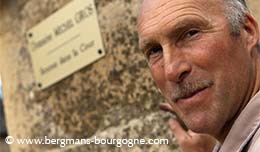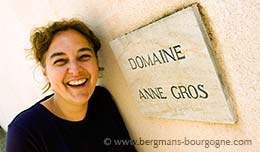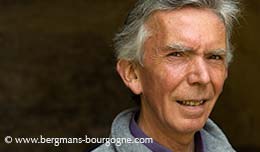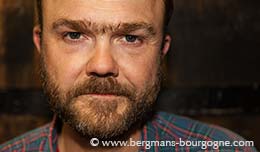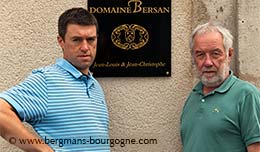
ean-Michel Chartron at Domaine Jean Chartron in Puligny-Montrachet has a firm grip on his own village. Two grand crus, three premier crus – two of which are monopoles – as well as a chunk of village Puligny-Montrachet. Historically this is where the focus of the domaine has been, but recent years have seen more acquisitions in neighbouring villages.
– Saint-Aubin is very close to Puligny-Montrachet, says Jean-Michel Chartron. The structure of the soil is the same.
– The village used to be in the shadow of Puligny-Montrachet, Chassagne-Montrachet and Meursault. Now it is becoming less and less so. Now I think Saint-Aubin is the the fourth village of top white Burgundy. Saint-Aubin has gained in reputation and there are some lovely domaines in the village now. It's a village where we have already invested and where we will invest more in the future, because the wines are great and the price of land is not as high as in Puligny-Montrachet, Chassagne-Montrachet or Meursault yet.
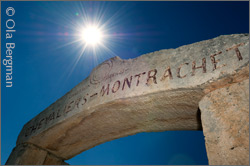 Jean-Michel Chartron represents the fifth generation at the domaine. The domaine was originally created in 1873 by Jean-Edouard Dupard, a cooper/craftsman also responsible for adding the Montrachet bit to the village name during his time as mayor of Puligny.
Jean-Michel Chartron represents the fifth generation at the domaine. The domaine was originally created in 1873 by Jean-Edouard Dupard, a cooper/craftsman also responsible for adding the Montrachet bit to the village name during his time as mayor of Puligny.
– At that time, at the time of my great-great-grandfather, wine was not the only activity here. He was a cooper and he was doing wine on the side. The majority, if not all of the wine was sold to the négociants in Beaune.
One important reason for selling to the négociants was the lack of underground cellars in the village. The high water table makes it difficult building a proper cellar here. Today there are cooling systems for cellars overground. Back then the outside temperature had a great impact.
– The temperature would be quite high in the summer, says Jean-Michel Chartron, so keeping the wine here was nearly impossible. Still today there are few growers in Puligny-Montrachet bottling themselves.
 – Until relatively recently the production of Domaine Jean Chartron was sold to négociants. The last contract came to an end in 1989. That was the Puligny-Montrachet premier cru Clos Cailleret which was sold by Joseph Drouhin.
– Until relatively recently the production of Domaine Jean Chartron was sold to négociants. The last contract came to an end in 1989. That was the Puligny-Montrachet premier cru Clos Cailleret which was sold by Joseph Drouhin.
– In the late 1990's my father bought the Saint-Aubin, Les Murgers des Dents de Chien. Then some Chassagne-Montrachet a few years later. I then rented the Rully vines in 2006, and bought the Chassagne-Montrachet, Cailleret, the Saint-Aubin, Les Perrières and the Savigny-lès-Beaune blanc (replanted, first harvest in 2011). The Bâtard-Montrachet, which we produce three of, was added in 2001 and the Corton-Charlemagne, which we produce two barrels of, in 2006.
 Today Domaine Jean Chartron covers 13 hectares. The three monopoles – the grand cru Chevalier-Montrachet, Clos des Chevaliers and the two premier crus Puligny-Montrachet, Clos du Cailleret and Puligny-Montrachet, Clos de la Pucelle – have been in the family since 1917.
Today Domaine Jean Chartron covers 13 hectares. The three monopoles – the grand cru Chevalier-Montrachet, Clos des Chevaliers and the two premier crus Puligny-Montrachet, Clos du Cailleret and Puligny-Montrachet, Clos de la Pucelle – have been in the family since 1917.
– I don't have any records of the Chevalier-Montrachet transaction, says Jean-Michel Chartron. I have a map from 1901, so it looks like the transaction took some time. But that's all I have, I have no price.
– Both Chevalier-Montrachet and Cailleret were already well-known back then. Pucelles, just downslope of Cailleret, was less so. Up until 1924 there was some aligoté planted there and the wine was sold as Grand Ordinaire, not Puligny-Montrachet.
– In Cailleret there was some pinot noir. There still is and I make a barrel or two every year. It's made by hand, using a small manual press. I make it for my family and my friends. It is the only red premier cru produced in Puligny-Montrachet.
 Clos des Chevaliers occupies roughly six per cent of the surface area of Chevalier-Montrachet, just above Montrachet itself. As the word clos suggests it is surrounded by walls. The walls were there already when the domaine acquired the vineyard in 1917. They are believed to have been built around 1890.
Clos des Chevaliers occupies roughly six per cent of the surface area of Chevalier-Montrachet, just above Montrachet itself. As the word clos suggests it is surrounded by walls. The walls were there already when the domaine acquired the vineyard in 1917. They are believed to have been built around 1890.
– I think the walls have some effect, says Jean-Michel Chartron. If you go to the vineyard you'll see that the northern wall is quite high, at least two and a half metres. This protects the vines from the north-wind. So in terms of maturity of the grapes I believe it has an influence. To me there is no other explanation to why the wall would be so high. It's OK to build a wall of normal height. But a high wall like this, there must be a reason.
The premier cru Le Cailleret is the northern extension of Montrachet. Close to one third of this climat is Clos du Cailleret. It is a more complex and powerful wine than its neighbour just 10 metres downslope, Clos de la Pucelle.
– Clos de la Pucelle is right beside Bâtard-Montrachet. There is more chalk in Clos du Cailleret than in Clos de la Pucelle. Cailleret could be translated as "the field old stones". You have Caillerets in several villages, in Chassagne-Montrachet, in Puligny-Montrachet and in Volnay. All of them have these white pieces of limestone. You find them in Chevalier-Montrachet as well.
 Compared to Montrachet the soil of Chevalier-Montrachet stonier. Montrachet has a little bit more clay and iron oxide, which creates a more reddish soil. With more limestone in Chevalier-Montrachet the soil there becomes more yellowish.
Compared to Montrachet the soil of Chevalier-Montrachet stonier. Montrachet has a little bit more clay and iron oxide, which creates a more reddish soil. With more limestone in Chevalier-Montrachet the soil there becomes more yellowish.
– Bâtard-Montrachet could be described as a little bit more opulent than Montrachet, says Jean-Michel Chartron. To me Montrachet and Chevalier-Montrachet are of the same structure. Bâtard-Montrachet is lower down on the hill and richer in style. Not as fine. There are some years when Montrachet and Chevalier-Montrachet easily can compete. Bâtard-Montrachet is always a step below, and Criots-Bâtard-Montrachet and Bienvenue-Bâtard-Montrachet.
The village level Puligny-Montrachet is a blend from several climats – Reuchaux, Levrons, Derrière la Velle and Tremblots. The first three are on the Meursault side of Puligny, the fourth is on the Chassagne side. The average annual production is 20 barrels.
 – Sometimes we add one or two barrels of premier cru. This adds a nice minerality and nice floral fragrances.
– Sometimes we add one or two barrels of premier cru. This adds a nice minerality and nice floral fragrances.
When it comes to the philosophy of the domaine Jean-Michel Chartron describes it as very traditional.
– First of all the pressing is done with whole bunches, he says. We use a pneumatic press and press slowly, usually around two and a half hours. The juice stays in the tank for about twelve hours for cold sedimentation. Then it is pumped with the fine lees directly into the barrels.
– The barrels are classic 228 litre barrels or 500 litre barrels. The percentage of new oak depends on the wine. The aim is to show the differences in terroir. If you make a wine too big, too opulent, too rich, then you will hide the characteristics of the wine.
Herbicides were banned from Domaine Jean Chartron in the early 1980's and Jean-Michel Chartron describes the work in the vineyards as organic.
– But we are not certified, he says, because I already have enough paperwork. On the other I don't want to sacrifice a vintage in case of very bad weather. I am not a viticultural extremist. Organic is great. Biodynamic has some great things. But I don't stick to all this. The most important thing is working the soil and avoiding herbicides.
© 2011 Ola Bergman










